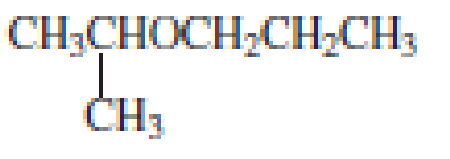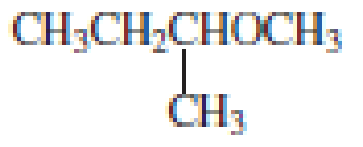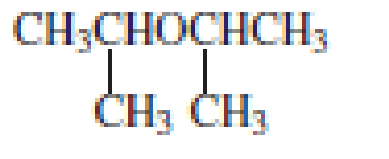
What are the common and systematic names of the following ethers?

- a. CH3CH2CH2CH2OCH2CH3


(a)
Interpretation:
The systematic name and the common name of the given ether have to be given.
Concept introduction:
IUPAC naming of Ether compounds:
An ether group consists of oxygen atom attached between two carbon chains. The shorter of two chains becomes the first part of the name with ‘ane’ changes to ‘oxy’ and the longer alkane becomes the suffix of the name of the ether.
When the Oxygen is not at the terminal position of main chain of alkane, then the shorter alkyl group and the ether group together are treated as a side chain and prefixed with its position of bonding on the main chain.
Common name for ether compounds:
- The name of the groups attached to the oxygen has to be given in alphabetical order followed by the word ether.
Explanation of Solution
The structure of the compound is given below:

From the structure of the compound, it is understood that the compound is an ether with three carbons in the parent chain. Hence, the parent chain will be propane. The numbering of the longest chain will be in such a way to get the carbon atom attached to the oxygen the possible lowest number.

The shorter alkyl group attached to the oxygen is the isopropyl group.
Therefore, systematic name of the compound is given below:

The common name of the compound can be identified by naming the alkyl groups attached to the oxygen followed by the word ether. In the given compound, one iso propyl group and one propyl group is attached to oxygen.
Therefore, common name of the compound is given below:
Propyl isopropyl ether
(b)
Interpretation:
The systematic name and the common name of the given ether has to be given.
Concept introduction:
IUPAC naming of Ether compounds:
An ether group consists of oxygen atom attached between two carbon chains. The shorter of two chains becomes the first part of the name with ‘ane’ changes to ‘oxy’ and the longer alkane becomes the suffix of the name of the ether.
When the Oxygen is not at the terminal position of main chain of alkane, then the shorter alkyl group and the ether group together are treated as a side chain and prefixed with its position of bonding on the main chain.
Common name for ether compounds:
- The name of the groups attached to the oxygen has to be given in alphabetical order followed by the word ether.
Explanation of Solution
The structure of the compound is given below:

From the structure of the compound, it is understood that the compound is an ether with four carbons in the parent chain. Thus the parent chain will be butane. The numbering of the longest chain will be in such a way to get the carbon atom attached to the oxygen the possible lowest number.

The shorter alkyl group attached to the oxygen that is in the first carbon is the ethyl group and therefore, the prefix will be “ethoxy”.
Therefore, the systematic name of the compound is given below:

The common name of the compound can be identified by naming the alkyl groups attached to the oxygen followed by the word ether. In the given compound, one ethyl group and one butyl group is attached to oxygen.
Therefore, common name of the compound is given below:
butyl ethyl ether.
(c)
Interpretation:
The systematic name and the common name of the given ether has to be given.
Concept introduction:
IUPAC naming of Ether compounds:
An ether group consists of oxygen atom attached between two carbon chains. The shorter of two chains becomes the first part of the name with ‘ane’ changes to ‘oxy’ and the longer alkane becomes the suffix of the name of the ether.
When the Oxygen is not at the terminal position of main chain of alkane, then the shorter alkyl group and the ether group together are treated as a side chain and prefixed with its position of bonding on the main chain.
Common name for ether compounds:
- The name of the groups attached to the oxygen has to be given in alphabetical order followed by the word ether.
Explanation of Solution
The structure of the compound is given below:

From the structure of the compound, it is understood that the compound is an ether with four carbons in the parent chain. Thus the parent chain will be butane. The numbering of the longest chain will be in such a way to get the carbon atom attached to the oxygen the possible lowest number.

The oxygen is attached to the second carbon.
The shorter alkyl group attached to the oxygen is the methyl group and therefore, the prefix will be “methoxy”.
Therefore, the systematic name of the compound is given below:

The common name of the compound can be identified by naming the alkyl groups attached to the oxygen followed by the word ether. In the given compound, one sec-butyl group and one methyl group is attached to oxygen.
Therefore, common name of the compound is given below:
Sec-butyl methyl ether.
(d)
Interpretation:
The systematic name and the common name of the given ether has to be given.
Concept introduction:
IUPAC naming of Ether compounds:
An ether group consists of oxygen atom attached between two carbon chains. The shorter of two chains becomes the first part of the name with ‘ane’ changes to ‘oxy’ and the longer alkane becomes the suffix of the name of the ether.
When the Oxygen is not at the terminal position of main chain of alkane, then the shorter alkyl group and the ether group together are treated as a side chain and prefixed with its position of bonding on the main chain.
Common name for ether compounds:
- The name of the groups attached to the oxygen has to be given in alphabetical order followed by the word ether.
Explanation of Solution
The structure of the compound is given below:

From the structure of the compound, it is understood that the compound is an ether with three carbons in the parent chain. Hence, the parent chain will be propane.

The shorter alkyl group attached to the oxygen that is in the second carbon is the isopropyl group and therefore, the prefix of the name will be “isopropoxy”.
Therefore, systematic name of the compound is given below:

The common name of the compound can be identified by naming the alkyl groups attached to the oxygen followed by the word ether. In the given compound, diisopropyl groups are attached to oxygen.
Therefore, common name of the compound is given below:
disopropyl ether.
Want to see more full solutions like this?
Chapter 9 Solutions
Essential Organic Chemistry (3rd Edition)
- Understanding the general acid-base properties of amino acids O Proteins Imagine each of the molecules shown below was found in an aqueous solution. Can you tell whether the solution is acidic, basic, or neutral? molecule The solution is... 010 H3N-CH-C-OH CH HO CH3 O acidic O basic neutral O (unknown) H3N HO 0 O acidic O basic neutral ○ (unknown) H3N-CH-C-O CH2 CH3-CH-CH3 O acidic O basic Oneutral ○ (unknown) O= X H2N-CH-C-O CH3 CH CH3 acidic O basic O neutral ○ (unknown) ? 000arrow_forwardImagine each of the molecules shown below was found in an aqueous solution. Can you tell whether the solution is acidic, basic, or neutral? molecule 0=0 H3N-CH-C-o HO CH2 OH The solution is... O acidic O basic O neutral O (unknown) H₂N acidic O basic O neutral ○ (unknown) + H3N O OH O acidic O basic O neutral O (unknown) H2N-CH-C-O CH3 O acidic O basic neutral ○ (unknown) X ? olo HEarrow_forwardRecognizing ampli Draw an a amino acid with a methyl (-CH3) side chain. Explanation Check Click and drag to start drawing a structure. X Carrow_forward
- Write the systematic name of each organic molecule: structure name × HO OH ☐ OH CI CI O CI OH OHarrow_forwardく Check the box under each a amino acid. If there are no a amino acids at all, check the "none of them" box under the table. Note for advanced students: don't assume every amino acid shown must be found in nature. COO H3N-C-H CH2 HO CH3 NH3 O CH3-CH CH2 OH Onone of them Explanation Check + H3N O 0. O OH + NH3 CH2 CH3-CH H2N C-COOH H O HIC + C=O H3N-C-O CH3- - CH CH2 OH Х 2025 McGraw Hill LLC. All Rights Reserved. Terms of Use | Privacy Center Accesarrow_forwardWrite the systematic name of each organic molecule: structure HO-C-CH2-CH3 O -OH CH3-CH2-CH2-CH2-CH2-C-OH CH3 CH3-CH-CH2-C-OH Explanation Check S namearrow_forward
- theres 2 productsarrow_forwardDraw the major product of this solvolysis reaction. Ignore any inorganic byproducts. + CH3CH2OH Drawing Q Atoms, Bonds and Rings OCH2CH3 || OEt Charges OH 00-> | Undo Reset | Br Remove Done Drag To Pan +arrow_forwardDraw the major product of this SN1 reaction. Ignore any inorganic byproducts. CH3CO2Na CH3CO2H Drawing + Br Q Atoms, Bonds and Rings OAC Charges OH ОАс Na ဂ Br Undo Reset Remove Done Drag To Pan +arrow_forward
- Organic Functional Groups entifying positions labeled with Greek letters in acids and derivatives 1/5 ssible, replace an H atom on the a carbon of the molecule in the drawing area with a ce an H atom on the ẞ carbon with a hydroxyl group substituent. ne of the substituents can't be added for any reason, just don't add it. If neither substi er the drawing area. O H OH Oneither substituent can be added. Check D 1 Accessibility ado na witharrow_forwardDifferentiate between electrophilic and nucleophilic groups. Give examples.arrow_forwardAn aldehyde/ketone plus an alcohol gives a hemiacetal, and an excess of alcohol gives an acetal. The reaction is an equilibrium; in aldehydes, it's shifted to the right and in ketones, to the left. Explain.arrow_forward
 Chemistry for Today: General, Organic, and Bioche...ChemistryISBN:9781305960060Author:Spencer L. Seager, Michael R. Slabaugh, Maren S. HansenPublisher:Cengage Learning
Chemistry for Today: General, Organic, and Bioche...ChemistryISBN:9781305960060Author:Spencer L. Seager, Michael R. Slabaugh, Maren S. HansenPublisher:Cengage Learning Organic And Biological ChemistryChemistryISBN:9781305081079Author:STOKER, H. Stephen (howard Stephen)Publisher:Cengage Learning,
Organic And Biological ChemistryChemistryISBN:9781305081079Author:STOKER, H. Stephen (howard Stephen)Publisher:Cengage Learning, General, Organic, and Biological ChemistryChemistryISBN:9781285853918Author:H. Stephen StokerPublisher:Cengage Learning
General, Organic, and Biological ChemistryChemistryISBN:9781285853918Author:H. Stephen StokerPublisher:Cengage Learning



